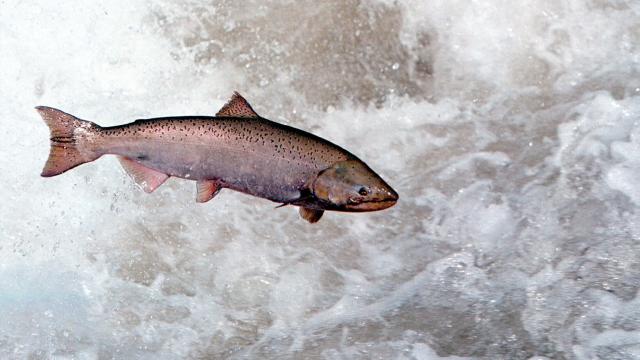If you’re the type who only buys wild fish to eat and would never touch the farmed stuff, just know the two may not be as separate as you think. New research published in Science Advances on Wednesday found that an infectious virus known as Piscine orthoreovirus-1, or PRV-1, may have spread from Atlantic salmon aquafarms to wild Pacific salmon.
PRV-1 is a virus common in salmon that has been shown to cause Atlantic salmon populations to have heart and skeletal muscle inflammation. It’s also been associated with a different disease increasingly found in Pacific salmon — specifically, wild Chinook salmon, whose populations are in decline.
In Chinook salmon, PRV-1 has been linked to a condition known as jaundice/anemia, which causes the fishes’ red blood cells to burst and their abdomens and under-eye area to turn yellow. More importantly, it can lead to deadly liver and kidney damage in the wild salmon.
Atlantic salmon farms have popped up in the Pacific Northwest, including near areas where wild salmon run. Until now, the role that salmon farms have played in the spread of PRV-1 to wild salmon in the region has been a big question mark. To clarify it, the authors studied different genetic sequences (or all the nucleotides that make up all the chromosomes of a virus) of PRV-1 from around the world, dating back to 1988.
“We sequenced the genomes of viruses infecting 86 different fish in BC [British Columbia], and combined these with previously published sequences to conduct our analysis,” Gideon Mordecai, the study’s lead author and a professor of University of British Columbia’s Earth, ocean, and atmospheric sciences department, wrote in an email.
By sequencing the order of nucleotides genome that make up a virus’ DNA, scientists can trace its evolution. The differences in a genetic sequence can provide clues about how a virus originated and spread to different locations. There are numerous applications, including how scientists have traced covid-19 mutations.
“We did this at different scales, to track transmission between oceans, but also more locally, between different populations of salmon off the coast of British Columbia” said Mordecai.
The authors’ findings indicate that a strain of the virus found in Northeast Pacific Chinook populations came from the same lineage as the cases found in the Atlantic Ocean. They estimate that this spread happened in 1989.
That’s much earlier than the first report of jaundice/anemia disease from the virus in 2002. But the timeline makes sense, as it suggests that the virus came to the Pacific around the same time salmon farms in the region imported Atlantic salmon eggs from Europe. It’s possible that when those eggs were fertilised and hatched, those fish carried the disease to the wild Chinook populations. Though the authors haven’t proved that the eggs brought the virus to the Pacific salmon, the timing lines up.
Currently, PRV-1 is running rampant in farms where Atlantic salmon are raised. The authors found that more than 97% of fish in all Atlantic salmon farms had the virus by the time they were 18 months into the aquacultural production cycle. From those farms, the authors’ findings suggest, PRV-1 is continually spreading to wild Pacific salmon.
The way the virus spreads is pretty gross: It gets transmitted through the infected fishes’ poop, which gets carried through the water. It then infects other fish through their gills, skin, and intestines.
This isn’t just disgusting. It’s also potentially devastating for wild Chinook populations, which are already facing numerous threats like overfishing, encroaching human development, and habitat loss. The authors suspect that infectious disease has also played a role in their decline.
Dwindling Chinook salmon populations, Mordecai noted, have wrought havoc on Indigenous people who depend on them for nourishment and fishing economies. The declines have also thrown ecosystems out of whack. A wide array of wildlife, including killer whales, bears, and seals, all prey on the fish. Thankfully, the authors also pose several ways policymakers could take on these issues.
“Our study highlights the need for robust regulation of aquaculture that may prevent future losses in wild populations, which we propose may be exacerbated by PRV-1 and other emerging infectious diseases,” the authors write.
For instance, PRV-1 is very common in Canada’s Atlantic Ocean salmon farms. But the country doesn’t classify the virus as a disease agent. To better regulate the spread of the disease, Mordecai said, the country should formally recognise the role PRV plays in salmon disease. He said there are also growing calls to move fish farms out of the ocean and onto the land or to otherwise contain them in some way.
“These would largely solve the issues of disease transmission to wild fish,” he said.
